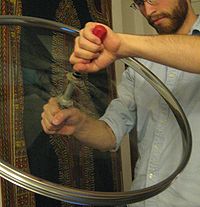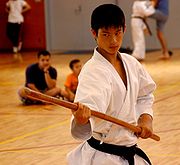
Twirling
Encyclopedia

Object manipulation
Object manipulation is a form of dexterity play or performance in which one or more artists physically interact with one or more objects. These can be special props made for the purpose of the manipulation itself - such as balls, clubs, hoops, rings, poi, staff, devil sticks, etc. - or any other...
, juggling
Juggling
Juggling is a skill involving moving objects for entertainment or sport. The most recognizable form of juggling is toss juggling, in which the juggler throws objects up to catch and toss up again. This may be one object or many objects, at the same time with one or many hands. Jugglers often refer...
and general dexterity play community.
Poi
Poi is a form of jugglingJuggling
Juggling is a skill involving moving objects for entertainment or sport. The most recognizable form of juggling is toss juggling, in which the juggler throws objects up to catch and toss up again. This may be one object or many objects, at the same time with one or many hands. Jugglers often refer...
, dance
Dance
Dance is an art form that generally refers to movement of the body, usually rhythmic and to music, used as a form of expression, social interaction or presented in a spiritual or performance setting....
or performance art, accomplished using balls, or various other weights, on ropes — held in each hand, and swung in various circular patterns, similar to club-twirling
Indian clubs
Indian clubs belong to a category of exercise equipment that was popular in the late 19th and early 20th centuries in Europe, the British Commonwealth and the United States. They comprise bowling-pin shaped wooden "clubs" of varying sizes and weights, which are swung in certain patterns as part...
. It was originally practiced by the Māori people of New Zealand
New Zealand
New Zealand is an island country in the south-western Pacific Ocean comprising two main landmasses and numerous smaller islands. The country is situated some east of Australia across the Tasman Sea, and roughly south of the Pacific island nations of New Caledonia, Fiji, and Tonga...
(the word poi means "ball" in Māori).
Pen spinning
Pen spinning — using one's fingers to manipulate an ordinary inexpensive writing-pen — can be performed anywhere. Sometimes classified as a form of contact jugglingContact juggling
Contact juggling is a form of object manipulation that focuses on the movement of objects such as balls in contact with the body. Although often used in conjunction with "toss juggling", it differs in that it involves the rolling of one or more objects without releasing them into the air...
, pen spinning may also include tossing and catching of the pen.
Called "rōnin mawashi" in Japan, where it is popular among the pre-collegiate community, pen twirling has its stars, as does any other performance or skill. Accomplished masters of the art form that are well known — at least among those who follow the sport — have developed a reputation for creation of certain signature 'moves'. David Weis is credited with creating numerous 'back' style moves, such as the "BackAround". Hideaki Kondoh is generally credited with giving the pen trick "Sonic" its name, because of the way the pen would blur in his fingers.
Penspinning only recently saw a rapid increase in recognition due to the emergence of internet media websites such as YouTube. From 2006 onwards, the art of Penspinning has developed subcultures in many countries of the world including the Asiatic-regions and Europe (France, Germany and Poland). .
Baton twirling
Baton twirling has expanded beyond parades and is now more comparable to rhythmic gymnastics (see below). The sport is popular in many countries including the United States, Japan,Spain, France, Italy, the Netherlands and Canada. Many countries compete each year at the World Baton Twirling Championships.There are many struts that you can compete in such as Basic strut, Military strut, fancy strut, pompon strut and x-strut.
There are also many routines for example: solo, dance solo, and duet
Also there are the team events which include Twirl team, dance team, pom pom team and military formation
One of the highest honors in twirling is winning "WBTF Gold Medalist."
Astrowheeling

Rhythmic gymnastics
Combining elements of ballet, gymnasticsGymnastics
Gymnastics is a sport involving performance of exercises requiring physical strength, flexibility, agility, coordination, and balance. Internationally, all of the gymnastic sports are governed by the Fédération Internationale de Gymnastique with each country having its own national governing body...
, theatrical dance, and apparatus manipulation, Rhythmic Gymnastics, once largely considered a sport for women and girls, is growing in popularity among men as well. The Japanese's version of Men's rhythmic gymnastics includes tumbling and is performed on a spring floor. Men compete in four types of apparatus: rope, stick, double rings and clubs. Groups do not use any apparatus. Japan hosted the first men's world championships in 2003.
Rhythmic gymnastics as a sport began in the 1940s in the former Soviet Union. It was there that for the first time, the spirit of sports was combined with the sensuous art of classical ballet. (To Isadora Duncan, we credit the famous rebellion against the dogma of classical ballet and the shift toward the creation of a new discipline that would blend art and sport.)
Recognized in 1961 as 'modern gymnastics', later 'rhythmic sportive gymnastics', rhythmic gymnastics experienced its first World Championships for individual gymnasts in 1963 in Budapest.
Today, Rhythmic gymnastics as a sport continues on, and hobbyists have adopted rhythmic gymnastics props such as the women's Ball
Ball (rhythmic gymnastics)
The Ball is a piece of apparatus used in rhythmic gymnastics. It is made of either rubber or synthetic material provided it possesses the same elasticity as rubber. It is from 18 to 20 cm in diameter and must have a minimum weight of 400g. The ball can be of any colour...
, Clubs, Hoop
Hoop (rhythmic gymnastics)
A hoop is an apparatus in rhythmic gymnastics and may be made of plastic or wood, provided that it retains its shape during the routine. The interior diameter is from 51 to 90 cm, and the hoop must weigh a minimum of 300g...
, Ribbon
Ribbon (rhythmic gymnastics)
Ribbon is a component of rhythmic gymnastics.-The stick:This can be of any colour and made of wood, bamboo, plastic or fibreglass with a maximum diameter of 1cm at its widest, a cylindrical or conical shape and should have a length of 50–60cm...
, and Rope
Rope (rhythmic gymnastics)
Rope may be made of hemp or a synthetic material which retains the qualities of lightness and suppleness. Its length is in proportion to the size of the gymnast. The rope should, when held down by the feet, reach both of the gymnasts' armpits. One or two knots at each end are for keeping hold of...
, plus the stick and rings of men's gymnastics, as exercise and recreational gear. These props have found their way into the modern 'juggling
Juggling
Juggling is a skill involving moving objects for entertainment or sport. The most recognizable form of juggling is toss juggling, in which the juggler throws objects up to catch and toss up again. This may be one object or many objects, at the same time with one or many hands. Jugglers often refer...
and dexterity play community' where they are used to perform tricks and maneuvers for fun fitness, and flexibility.
Devil sticks
"Twirling", "sticking" and "stick juggling" — are all common terms for using the twirling prop known as a devil stick or flower stick or by various other names. A set of devil sticks is made up of three pieces - the baton and two control sticks.In use the central stick, the baton, is pushed, lifted and caressed by the two control sticks causing the stick to flip, wobble, spin, and fly through various maneuvers or tricks.
Juggling Sticks similar to the modern variants have continuously evolved as they were passed down through the centuries. Apparently originating in Africa earlier than 3000 BCE, 'devil sticks' may have followed the Silk Road
Silk Road
The Silk Road or Silk Route refers to a historical network of interlinking trade routes across the Afro-Eurasian landmass that connected East, South, and Western Asia with the Mediterranean and European world, as well as parts of North and East Africa...
, from Cairo to China
China
Chinese civilization may refer to:* China for more general discussion of the country.* Chinese culture* Greater China, the transnational community of ethnic Chinese.* History of China* Sinosphere, the area historically affected by Chinese culture...
, and have been used in Europe
Europe
Europe is, by convention, one of the world's seven continents. Comprising the westernmost peninsula of Eurasia, Europe is generally 'divided' from Asia to its east by the watershed divides of the Ural and Caucasus Mountains, the Ural River, the Caspian and Black Seas, and the waterways connecting...
since the Renaissance
Renaissance
The Renaissance was a cultural movement that spanned roughly the 14th to the 17th century, beginning in Italy in the Late Middle Ages and later spreading to the rest of Europe. The term is also used more loosely to refer to the historical era, but since the changes of the Renaissance were not...
.
Morris dancing
In some forms of Morris dancingMorris dance
Morris dance is a form of English folk dance usually accompanied by music. It is based on rhythmic stepping and the execution of choreographed figures by a group of dancers. Implements such as sticks, swords, handkerchiefs and bells may also be wielded by the dancers...
, a stick is twirled in one hand during a dance. For example, in stick dances from Brackley
Brackley
Brackley is a town in south Northamptonshire, England. It is about from Oxford and miles form Northampton. Historically a market town based on the wool and lace trade, it was built on the intersecting trade routes between London, Birmingham and the English Midlands and between Cambridge and Oxford...
in the Cotswold tradition, each dancer twirls one or two sticks throughout the dance.
Staff twirling

Quarterstaff
A quarterstaff , also short staff or simply staff is a traditional European pole weapon and a technique of stick fighting, especially as in use in England during the Early Modern period....
, bo
Bo (weapon)
A bō or kon , is a long staff weapon used in Okinawa and feudal Japan. Bō are typically around long and are now used in Japanese martial arts, in particular bōjutsu...
, or other long length of wood, metal or plastic as recreation, sport or as a performance.
In the martial art of bojutsu, a bo is used as a weapon, increasing the force delivered in a strike, through leverage. Bojitsu kata — detailed patterns of movements practiced to perfect one's form, are also used in many traditional Japanese arts such as kabuki. Some of these kata, or forms, are very flowing and pleasant to experience, both as the one executing the movement and as a spectator, and hint at the flowing moves of the recreational stick manipulator.
Staff twirling has enjoyed recent growth in the dexterity play, juggling
Juggling
Juggling is a skill involving moving objects for entertainment or sport. The most recognizable form of juggling is toss juggling, in which the juggler throws objects up to catch and toss up again. This may be one object or many objects, at the same time with one or many hands. Jugglers often refer...
and fire dancing
Fire dancing
Fire dancing is a group of performance arts or disciplines that involve manipulation of objects on fire...
communities, in part due to the influence of martial arts, and in part due to increasing popularity of adult play as recreation.

